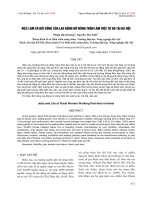- Trang chủ >>
- Khoa Học Tự Nhiên >>
- Vật lý
Land development handbook
Bạn đang xem bản rút gọn của tài liệu. Xem và tải ngay bản đầy đủ của tài liệu tại đây (22.3 MB, 1,249 trang )
Dewberry®
iii
LAND DEVELOPMENT HANDBOOK
PLANNING, ENGINEERING, AND SURVEYING
Dewberry®
Editor-in-Chief: Sidney O. Dewberry
Coordinating Editor: Lisa N. Rauenzahn
THIRD EDITION
MCGRAW-HILL
New York Chicago San Francisco Lisbon London Madrid
Mexico City Milan New Delhi San Juan Seoul
Singapore Sydney Toronto
Dewberry®
iv
Library of Congress Cataloging-in-Publication Data
Land development handbook : planning, engineering, and surveying / Dewberry ;
Sidney O. Dewberry, editor-in-chief ; Lisa N. Rauenzahn, coordinating editor.—3rd ed.
p. cm.
Includes bibliographical references and index.
ISBN 978-0-07-149437-3 (alk. paper)
1. Surveying—Handbooks, manuals, etc. 2. Real estate development—Planning—
Handbooks, manuals, etc. 3. Engineering geology—Handbooks, manuals, etc.
I. Dewberry, Sidney O. II. Rauenzahn, Lisa N. III. Dewberry.
TA549.L29 2008
690—dc22 2008014415
Copyright © 2008, 2002, 1996 by Dewberry.
All rights reserved. Printed in the United States of America. Except as permitted under the United States Copyright Act of
1976, no part of this publication may be reproduced or distributed in any form or by any means, or stored in a data base or
retrieval system, without the prior written permission of the publisher.
1 2 3 4 5 6 7 8 9 0 CCW/CCW 0 1 4 3 2 1 0 9 8
ISBN 978-0-07-149437-3
MHID 0-07-149437-5
Sponsoring Editor: Larry S. Hager
Production Supervisor: Richard C. Ruzycka
Editing Supervisor: Stephen M. Smith
Project Manager: Virginia Carroll, North Market Street Graphics
Copy Editors: Virginia Carroll and Stewart Smith
Proofreaders: Roberta Burkert, Linda Enterline, and Sue Miller
Indexer: Virginia Carroll
Art Director, Cover: Jeff Weeks
Composition: North Market Street Graphics
Printed and bound by Courier Westford, Inc.
McGraw-Hill books are available at special quantity discounts to use as premiums and sales promotions, or for use in
corporate training programs. To contact a special sales representative, please visit the Contact Us page at
www.mhprofessional.com.
LEED is a trademark of the U.S. Green Building Council.
This book is printed on acid-free paper.
Information contained in this work has been obtained by The McGraw-Hill Companies, Inc. (“McGraw-Hill”) from
sources believed to be reliable. However, neither McGraw-Hill nor its authors guarantee the accuracy or completeness of
any information published herein, and neither McGraw-Hill nor its authors shall be responsible for any errors, omissions,
or damages arising out of use of this information. This work is published with the understanding that McGraw-Hill and its
authors are supplying information but are not attempting to render engineering or other professional services. If such
services are required, the assistance of an appropriate professional should be sought.
Dewberry®
v
To the hardworking Dewberry employees who dedicate their talent, energy, and passion to building
amazing places.
Ours is a business in which a great deal of what we do has a visible and tangible impact on the world. I
love driving past the places our firm has had a hand in creating. Conference centers. Housing
developments. Lakes. Golf courses. Libraries. Churches. Bridges. Roads. Telecommunications facilities.
Small or large, they’re all something to be proud of. Such landmarks also provide a satisfying reminder:
when it comes to measuring the land, reshaping it, getting across it or building on it, Dewberry has done
it—and done it well—for a half century.
—Sidney O. Dewberry
The Dewberry Way: Celebrating 50 Years of Excellence, 13 April 2006
Dewberry®
BRIEF CONTENTS
I. OVERVIEW
1 Overview of the Land Development Process
II. FEASIBILITY AND SITE ANALYSIS
II.A Feasibility and Programming
2 Environmental Policy and Regulations
3 Environmental Site Feasibility and Assessments
4 Historic Architectural and Archaeological Resource Assessment
5 Engineering Feasibility
II.B Site Analysis: Allowable Use of Site
6 Real Property Law
7 Comprehensive Planning and Zoning
8 Subdivision Ordinances, Site Plan Regulations, and Building Codes
II.C Rezoning
9 The Rezoning Process
10 Exactions, Infrastructure Enhancements, and Fees
III. CONCEPTUAL DESIGN
11 Development Patterns and Principles
IV. SCHEMATIC DESIGN
IV.A Base Map Preparation
12 Control Surveys for Land Development
13 Boundary Surveys for Land Development
14 Topographic Surveys
IV.B Refinement of Previous Assumptions
15 Environmental and Natural Resources
16 Impacts to Historic Architectural and Archaeological Resources
17 Brownfield Redevelopment and Environmental Considerations
18 Floodplain Studies
19 Preliminary Engineering and Hydrologic Analysis
vii
Dewberry®
V. FINAL DESIGN
20 Street Design
21 Storm Drainage Design
22 Stormwater Management Design
23 Grading and Earthwork
24 Wastewater Collection
25 Water Distribution
26 Dry Utility Design and Engineering
27 Erosion and Sediment Control
28 Construction and Contract Documents
29 Construction Cost Estimating
VI. PLAN SUBMISSION AND PERMITTING
30 Plan Submission, Review, and Approval Process
31 Environmental Permits
32 Building Permits
VII. CONSTRUCTION
33 Construction Stakeout Surveys
34 Certificates of Occupancy and Postconstruction Services
VIII. TECHNICAL APPENDICES
App. A Aerial Mapping and Surveying
App. B Stream Restoration
App. C Soils
App. D Wastewater Treatment
App. E Water Supply and Treatment
App. F Case Study: Merrifield Town Center
App. G Technical Appendix
App. H Land Development Handbook
viii
Dewberry®
ix
CONTENTS
Foreword
About the Author
xxiii
xxv
Preface
xxvii
Contributors
xxxi
I. OVERVIEW
CHAPTER OVERVIEW OF THELANDDEVELOPMENT PROCESS
1 Sidney O. Dewberry, PE, LS
Introduction
Ŷ The Conversion of Land
In Search of “Greener” Pastures: A Back-to-the-Future Look at the
Land Development Industry
3
3
4
Ŷ Land Planning and Development in Historic Context
4
Ŷ Back to the Future: Where Do We Go from Here
8
Ŷ Building for Today’s Demographic
8
The Land Development Process
9
Ŷ Communication Skills
10
Ŷ Public Involvement
11
Ŷ Basis for Design
11
Ŷ Traditional Steps in the Land Development Design Process
14
Design: Understanding of Basic Requirements
16
Ŷ Design Elements
18
Ŷ Design Philosophies
19
Conclusion
19
Ŷ The Land Professional
19
Ŷ This Handbook
20
Acknowledgment
20
References
20
Additional Readings
20
II. FEASIBILITY AND SITE ANALYSIS
Step 1: Feasibility
23
Step 2: Site Analysis
Site Assessment
Ŷ Appreciation of Program
24
24
24
II.A. Feasibility and Programming
CHAPTER ENVIRONMENTALPOLICY ANDREGULATIONS
2 Jeffrey M. Moran, PE; Updated/Revised: Christina Gray
Introduction
35
Environmental Policy
35
Ŷ Federal Laws and Rule Making
36
Environmental Regulations
36
Ŷ Fish and Wildlife Coordination Act (1934, as amended through
1965)
36
Ŷ Federal Insecticide, Fungicide, and Rodenticide Act (FIFRA; 1947,
as amended through 1991)
37
Ŷ Clean Water Act (CWA; 1948, as amended through 1987)
37
Ŷ National Historic Preservation Act (NHPA; 1966, as amended
through 1992)
40
Ŷ Wild and Scenic Rivers Act (1968, as amended through 1974)
40
Ŷ National Environmental Policy Act (NEPA; 1970)
40
Ŷ Clean Air Act (CAA; 1970, as amended through 1990)
40
Ŷ Coastal Zone Management Act (CZMA; 1972, as amended through
1996)
42
Ŷ Endangered Species Act (1973, as amended through 1988)
42
Ŷ Safe Drinking Water Act (SDWA; 1974, as amended through 1996)
42
Ŷ Marine Protection, Research, and Sanctuaries Act (1972, as
amended through 1988)
42
Ŷ Toxic Substances Control Act (TSCA; 1976, as amended through
1988)
44
Ŷ Resource Conservation and Recovery Act (RCRA; 1976, as
amended through 1992)
44
Ŷ Noise Control Act (1972, as amended through 1978)
Ŷ Comprehensive Environmental Response, Compensation, and
Liability Act (CERCLA; 1980, as amended through 1986)
44
44
Ŷ Superfund Amendments and Reauthorization Act (SARA; 1986)
44
Ŷ Pollution Prevention Act (1990)
44
Ŷ Occupational Safety and Health Act (1970)
45
Ŷ Small Business Liability Relief and Brownfields Revitalization Act
(Brownfields Law; 2002)
45
Conclusion
46
Acknowledgment
46
References
46
Dewberry®
x
CHAPTER ENVIRONMENTALSITEFEASIBILITY AND ASSESSMENTS
3 Jeffrey Moran, PE; Updated/Revised: Stephanie B. Perez, PG
Introduction
47
Environmental Site Feasibility
47
Ŷ Preliminary Wetland Assessment
48
Ŷ Threatened and Endangered Species Habitat Review
49
Ŷ Cultural Resources Assessment
49
Ŷ Regulatory Database Review: Contamination Investigation
49
Ŷ Natural Hazard and Risk Assessment
49
Ŷ Site Walkover/Reconnaissance
49
Environmental Assessments under CERCLA and NEPA
50
Ŷ Environmental Site Assessment (ESA) under CERCLA—Due
Diligence
50
Ŷ NEPA Environmental Assessment (EA)
References
CHAPTER HISTORIC
ARCHITECTURAL
AND
ARCHAEOLOGICAL
4 RESOURCE ASSESSMENT
Elizabeth Couture, MURP, MARCH; Updated/Revised: Andrea Burk
Introduction
55
56
57
The Historic Preservation Movement
57
Getting Started: Know Your Project
60
What Is a Historic Property?
60
Ŷ Historic Property Identification
61
Ŷ Historic Architectural Resource Survey
62
Ŷ Archaeological Investigation
62
Legal Issues Pertaining to Preservation
62
Conclusions
63
References
63
CHAPTER ENGINEERING FEASIBILITY
5 Bill Fissel, PE; Updated/Revised: Jay Kruse, PE
Introduction
65
Engineering Feasibility Study
67
Ŷ Scope and Process of the Study
67
Ŷ Required Information
68
Ŷ Sources of Information
72
Ŷ Site Inspection
75
Ŷ Site Analysis Mapping and Report
77
Ŷ Yield Study
78
Ŷ An Alternative Study Approach
81
Ŷ Site Selection Study
82
Other Impact Studies
85
Ŷ Traffic Impact Study
85
Ŷ Community Impact Study
87
Ŷ Fiscal Impact Study
89
Ŷ Environmental Impact Study
89
Example of a Preliminary Feasibility Study
92
References
98
II.B Site Analysis: Allowable Use of Site
CHAPTER REAL PROPERTY LAW
6 Carlyle W. Blomme, RLS, J. Randall Minchew, Esq., Craig N. Thomas,
Esq.; Edited/Updated: Curt Sumner, LS, Gary Kent, LS; Updated/Revised:
Donald A. Wilson, LLS, PLS, RPF
Understanding Law to Guide in Boundary Determination
Ŷ Sources of Law
99
99
Ŷ Introduction to Property Law
101
Ŷ Classification of Property
101
Types of Estates and the History of Their Origin
102
Ŷ Modern Classification
103
Ŷ Fee Simple Estates
103
Ŷ Estates Not of Inheritance
103
Ŷ Concurrent Ownership
104
Ŷ Wills and Descent
104
Ownership and Transfer of Title of Real Property
104
Ŷ Deeds
104
Ŷ Land Descriptions
105
Ŷ Adverse Possession
105
Ŷ Easements
106
Ŷ Title Report
108
Ŷ Eminent Domain
109
Ŷ Dedication
109
Ŷ The Doctrine of Agreed Boundaries
109
Ŷ Created Boundaries by Acquiescence
110
Ŷ Created Boundaries by Estoppel
110
Ŷ Liens and Mortgages
111
Ŷ Action for Ejectment
111
Ŷ Surveys for Transfer of Developable Real Estate
111
Law of Evidence
111
Ŷ Indispensable Evidence
112
Ŷ Undisputed Evidence
112
Ŷ Prima Facie Evidence
112
Ŷ Additional Types of Evidence
112
Ŷ Collecting Evidence
112
Ŷ Consideration of Evidence
112
Dewberry®
xi
Water Law
113
Ŷ Riparian Rights
113
Ŷ Surface Water
114
Ŷ Subsurface Waters
114
Land Use
115
Ŷ Land Use Regulations
115
Ŷ Ordinances
115
Ŷ Restrictions
115
Ŷ Subdivision Development
115
Ŷ Shopping Centers
117
Ŷ Industrial Parks
117
Ŷ City-County Planning and Zoning
117
Summary
118
References
118
Additional Reading
118
CHAPTER COMPREHENSIVE PLANNING AND ZONING
7 Lawrence A. McDermott; Updated/Revised: Silvia D’Jaen Silverman,
AICP
Introduction
Comprehensive Planning
119
120
Ŷ Community Planning: A Participatory Process
121
Ŷ Composition and Characteristics of the Comprehensive Plan
122
Ŷ Establishment of Goals and Objectives
123
Ŷ Inventory and Trends
124
Ŷ Land Use Maps
124
Ŷ Plan Implementation
126
Ŷ What to Look For and How to Use the Comprehensive Plan
126
Zoning
128
Ŷ Introduction
128
Ŷ The Zoning Map
130
Ŷ What to Look For and How to Use the Zoning Ordinance and Map
130
Ŷ Zoning Administration
132
Ŷ Zoning Concepts
134
Ŷ Floating Zones
135
Zoning Changes
140
Ŷ Proffered Zoning
141
Ŷ Contract Zoning
141
Related Techniques in Development Regulation
141
Ŷ Adequate Public Facilities (APF) Ordinances
141
Ŷ Development Review Point Systems
142
Ŷ Deed Restrictions and Covenants
142
Ŷ Environmental Regulations
143
Smart Growth
144
Ŷ Introduction
144
Ŷ Fundamentals and Principles
144
Conclusion
145
References
146
CHAPTER SUBDIVISION ORDINANCES, SITE PLAN REGULATIONS, AND
8 BUILDING CODES
Lawrence A. McDermott; Updated/Revised: David L. Taylor, Jr., RLA
Introduction
Subdivision Ordinances
147
148
Ŷ Evolution of Subdivision Ordinances
148
Ŷ Components of Subdivision Ordinances
148
Ŷ Development Management and Review
152
Ŷ Guaranteed Performance
153
Ŷ Durability of Information
153
Ŷ Benefits to the Land Development Design Team
153
Ŷ Related Development Ordinances
153
Ŷ What to Look For and How to Use Subdivision Ordinances
154
Site Plan Regulations
155
Building Codes
156
References
156
II.C Rezoning
CHAPTER THE REZONING PROCESS
9 Lawrence A. McDermott; Updated/Revised: Megan M. Bramble, Esq.
Introduction
157
Technical Analysis of Rezoning
158
Ŷ Reasons for Rezoning
158
Ŷ Background Investigation
158
Administration of the Rezoning Process
Ŷ The Professional Planning Staff: Decision Influencers
160
160
Ŷ The Political Leaders: Decision Makers
161
Ŷ The Community: Friends Not Foes
162
Presentations
165
Ŷ Presentation Information and Graphics
166
Ŷ Review of the Application Submittal
167
Ŷ The Public Hearing and Role of the Development Team
167
Related Processes
177
Ŷ Comprehensive Plan Amendment
177
Ŷ Special Exceptions
177
Conclusion
177
References
178
Dewberry®
xii
CHAPTER EXACTIONS, INFRASTRUCTURE ENHANCEMENTS,
10 FEESLawrence A. McDermott
; Updated/Revised: Lisa N. Rauenzahn, PE, LEED AP
Introduction
AND
Exactions, Infrastructure Enhancements and Fees
179
179
Ŷ Land Reservation
180
Ŷ Dedications
180
Ŷ Preservation
181
Ŷ Payments-in-Lieu
181
Ŷ Impact Fees
182
Ŷ Linkage
183
Ŷ Review and Processing Fees
183
Conclusion
183
References
184
III. CONCEPTUAL DESIGN
Introduction
Step 3: Conceptual Design
CHAPTER DEVELOPMENT PATTERNS AND PRINCIPLES
11 Dennis Couture, ASLA, RLA; Updated/Revised: N. Andrew Bishop, LA,
Planner
Introduction
Development Patterns
185
185
187
188
Ŷ Conventional Subdivision
188
Ŷ New Approaches to Subdivision: Providing Design Flexibility
189
Ŷ Traditional Neighborhood Design (TND)
191
Ŷ Transit-Oriented Development (TOD)
194
Ŷ Active Adult Communities (age 55 and older)
194
Ŷ Mixed-Use Development
194
Ŷ Master Planned Communities
194
Development Principles
195
Ŷ Environmental Impacts and Opportunities
195
Ŷ Aesthetic Impacts and Opportunities
195
Ŷ Financial Impacts and Opportunities
196
Ŷ Operational Impacts and Opportunities
196
Ŷ Marketing Impacts and Opportunities
196
Residential Land Use
197
Ŷ Single-Family Detached Dwellings
197
Ŷ Design Considerations
198
Ŷ Single-Family Semidetached Dwellings
199
Ŷ Single-Family Attached Dwellings
199
Ŷ Live/Work Units
200
Ŷ Multifamily Residential Structures
201
Ŷ Site Design—Residential Development
205
Nonresidential Land Use
205
Ŷ Market Considerations
205
Ŷ Design Considerations
206
Retail
206
Ŷ Freestanding Retail Development
207
Ŷ Strip Centers
207
Ŷ Retail Center
207
Ŷ Retail Mall
208
Ŷ Main-Street Retail Development
208
Ŷ Retail Center Design Considerations
208
Ŷ Other Considerations
211
Office Uses: Overview
212
Ŷ Freestanding Office Buildings
212
Ŷ Office Park
213
Ŷ Garden Office
214
Ŷ Town House Office
214
Ŷ Office Design Principles
214
Industrial
214
Ŷ Heavy Industry
215
Ŷ Medium-Intensity and General Industrial Use
215
Ŷ Light Industrial Use
215
Ŷ Special Industrial Use Patterns
216
Ŷ Industrial/Office/Retail Hybrid Building Forms
216
Conclusion
218
References
219
IV. SCHEMATIC DESIGN
Introduction
Step 4: Schematic Design
221
221
Base Map
223
IV.A Base Map Preparation
CHAPTER CONTROL SURVEYS FOR LAND DEVELOPMENT
12 Joseph W. Betit, PLS
Introduction
225
Identify the History of Prior Project Control
227
Ŷ Following in the Survey Control Footsteps of Previous Project
Surveyors
227
Ŷ Geographic Information Systems (GIS) and Modern Survey
Control
227
Identify Your Local Agency Datums Regulatory Requirements
227
Ŷ Survey Control Metadata (Data Lineage)
Ŷ Determine Agency-Required Survey Specifications and Accuracy
Standards
227
229
Dewberry®
xiii
How to Handle the Multiple Coordinate Systems Characteristic of
Regional Infrastructure Projects
Determine Project-Specific Geospatial Accuracy Requirements
230
230
Ŷ Hydraulic Component
230
Ŷ Concrete and Prefabricated Structures
230
Designing and Planning the Project Survey Control Scheme
230
Overview of GNSS Methods
231
Typical Forms of Real-Time Kinematic (RTK) GPS Surveying
231
Ŷ Single Base Station Radio RTK with or without Repeater Radio
231
Ŷ Single Base Station Radio RTK with One or Two (Max.) Repeater
Radio(s)
231
Ŷ Multibase Network RTK
232
Ŷ Networked Base Station VRS RTK with Cell Phone
232
How Network RTK (VRS) and Single Base Radio RTK Work and
Their Differences
232
Ŷ Ease of Setup and Better Security of Equipment
232
Ŷ Range of Area of Operation of VRS versus Radio RTK
233
Ŷ Accuracy
233
Recommended VRS Positioning Procedures
Ŷ In the Box
VRS Precise Vertical Procedure
Ŷ What the Survey Controller Precision Estimates Mean
Guidelines: When to Use VRS RTK and Radio RTK—Lessons
Learned and Best Practice
233
233
234
236
236
Ŷ DOT Work
236
Ŷ Curb and Gutter and Other Concrete Structures
237
Ŷ ALTA Boundary and Control Recovery
237
Ŷ Aerial Mapping Control
237
Ŷ Initial Base Station Positioning for Radio RTK
237
Ŷ Setting Control Station Pairs for Large-Site Mapping
238
Ŷ As-Built Surveys
238
Vertical Accuracy Differences between VRS and RTK
238
Ŷ Project Size and Radio Reception Considerations When Selecting
VRS or Radio RTK for Projects
238
Review of U.S. Surveying Standards and Specifications
238
Ŷ Specifications
238
Ŷ National Datum Adjustment Lineage—Critical Knowledge for
Today’s Land Surveyor
Ŷ Global Positioning System (GPS)
Ŷ ACSM/ASPRS ALTA Standard—Classification and Specifications
for Cadastral Surveys
239
239
240
Ŷ National Map Accuracy Standards
241
Ŷ Equipment Specifications
241
Review of Surveying Statistics
241
Ŷ Accuracy and Precision
241
Ŷ Types and Sources of Error
243
Ŷ Probability Theory
243
Ŷ The DIN Specfor Conventional Survey Instruments
244
Legal Defensibility of Survey Control and GNSS RTN Positions in
Land Development Surveying
244
Overview of Adjustments
246
Ŷ Horizontal Adjustments
246
Ŷ Angular Adjustment
246
Ŷ Error of Closure
247
Ŷ Traditional Methods of Horizontal Adjustment
247
Ŷ Vertical Adjustments
247
Ŷ Least Squares
248
Overview of a Typical Least Squares Adjustment of Conventional
Survey Data
249
Acknowledgment
257
References
257
Additional Reading
257
CHAPTER BOUNDARY SURVEYS FOR LAND DEVELOPMENT
13 Gary Kent, LS; Updated/Revised: Karen Brill, PS
Introduction
259
Ŷ Property Surveying
259
Ŷ Functions of the Property Surveyor
259
Ŷ Legal Descriptions
260
Surveys for Boundary Location
261
Ŷ Encroachments and Gaps
261
Ŷ Importance of the Survey in Land Development
262
Ŷ Research of Land Records
262
Ŷ The Title Search
263
Ŷ Check of Adjoining Property
Analysis of Information and Preparation of Composite Map
265
265
Ŷ Monuments
266
Ŷ Discrepancies
266
Ŷ Preparing for the Fieldwork
267
Application of Information to the Boundary Survey
267
Ŷ Standards
267
Ŷ Fieldwork
267
Ŷ The Traverse Survey
267
Ŷ Locating Features and Improvements
269
Ŷ Easements
269
Ŷ Grave Sites
270
Ŷ Evidence of Possession
270
Ŷ Office Work and Computations
270
Ŷ Boundary Determination
271
Dewberry®
xiv
Legal Considerations in Boundary Determination
271
Ŷ Conflicting Title Elements
272
Ŷ Possession
272
Ŷ Senior Rights
272
Ŷ Written Intentions of the Parties
272
Ŷ Calls for Monuments
273
Ŷ Distance, Direction, Area, and Coordinates
273
Ŷ Boundaries by Agreement
273
Ŷ Boundaries by Acquiescence
273
Ŷ Boundaries by Estoppel
273
Ŷ Party Walls and Line Fences
273
Ŷ Evidence
273
Ŷ Basic Rules for Guidance in Boundary Location
274
Ŷ Informing the Client
275
Ŷ Preparation of the Final Map and Description
275
References
CHAPTER TOPOGRAPHIC SURVEYS
14 Carlyle W. Blomme, RLS, Mary M. Root, LS, Eric V. Day, PLS;
Updated/Revised: Curt Sumner, LS; Updated/Revised: Kirk W. Norton, PS,
LS, PLS, Thomas English, PLS, PP
Introduction
276
279
Planning Topographic Surveys
279
Gathering the Data
280
Photogrammetry and Topographic Mapping
280
Ŷ Advantages and Disadvantages
281
Ŷ Map Accuracies
281
Field Methods for Topographic Mapping
282
Ŷ General Procedures
282
Ŷ Electronic Mapping Using Conventional and GPS Methods
283
Ŷ Coordinating Field and Office Procedures for Electronic Survey
Systems
287
Baseline Topography
289
Determination of Strike and Dip of Outcrops
290
Summary
291
References
293
IV.B Refinement of Previous Assumptions
CHAPTER ENVIRONMENTAL AND NATURAL RESOURCES
15 Kimberly V. Larkin
Introduction
295
Wetlands
295
Ŷ Wetlands Defined
296
Ŷ Wetland Functions
297
Ŷ Wetland Losses
299
Ŷ Wetland Delineation Criteria and Methodology
300
Open-Space and Vegetation Preservation
303
Ŷ The Values and Benefits of Trees and Open Space
303
Ŷ Preservation/Protection Ordinances
305
Ŷ Open Space, Tree Preservation, and the Site Development Process
306
Ŷ Forest Preservation, Location, and Function
307
Ŷ Tree Protection during Construction
308
Ŷ Open-Space and Tree Preservation Plan
310
Summary
310
References
310
CHAPTER IMPACTS
TO
HISTORIC
ARCHITECTURAL
AND
16 ARCHAEOLOGICAL RESOURCES
Elizabeth Couture, MURP, MARCH; Updated/Revised: Andrea Burk
Introduction
313
Impact Assessment
313
Ŷ Defining Impacts
314
Ŷ Avoidance, Minimization, and Mitigation
314
Treatment of Historic Properties
314
Professional Qualification Standards
315
Successful Preservation Design Examples
315
Ŷ McNair Farms
315
Ŷ Chesapeake and Ohio (C&O) Canal
316
Ŷ Franklin Farm
317
Ŷ Riverside Drive
318
Summary
319
References
319
CHAPTER BROWNFIELD REDEVELOPMENT
17 CONSIDERATIONS
David Bausmith, PE
Introduction
AND
ENVIRONMENTAL
321
Brownfields by the Numbers
321
Ŷ Market Growth
323
Ŷ Regulatory Incentives
323
Ŷ Financial Incentives
324
Environmental Considerations
327
Ŷ Contamination Sources
328
Ŷ Regulatory Issues
336
Challenges and Solutions
337
Ŷ Remediation Technologies
338
Ŷ Engineering and Institutional Controls
341
Ŷ Integrated Remediation and Redevelopment
342
Dewberry®
xv
Conclusions
343
References
343
CHAPTER FLOODPLAIN STUDIES
18 Gilbert R. Jones, PE
Introduction
345
FEMA and the National Flood Insurance Program
345
Ŷ History of the NFIP
Ŷ Role of Municipal Governments and Lenders in Floodplain
Management under the NFIP
345
346
Ŷ FEMA Flood Map Products
346
Ŷ Flood Map Revisions
348
Ŷ Community- and Property Owner–Initiated Amendments and
Revisions
348
Ŷ Studies and Restudies
350
Ŷ Acceptable Flood Study Methodologies
350
Preparing a Floodplain Study
350
Ŷ Introduction
350
Ŷ Planning a Flood Study
350
Ŷ Data Acquisition
351
Ŷ Hydrologic Analysis
351
Ŷ Hydraulic Analysis
352
Ŷ Special Considerations
352
Ŷ Preparation of Deliverables
355
References
355
CHAPTER PRELIMINARY ENGINEERING AND HYDROLOGIC ANALYSIS
19 David A. Jordan, PE; Updated/Revised: Christopher M. Grrotti, PE
Introduction
357
Components of a Preliminary Engineering Study
358
Ŷ Site Layout and Roadway Design
Hydrologic Analysis
358
358
Ŷ Rainfall and Runoff
360
Ŷ Design Storms
361
Ŷ Intensity-Duration-Frequency Curves
361
Ŷ Rational Method Hydrology
365
Ŷ NRCS Methodology for Computing Runoff
378









